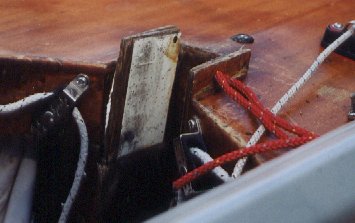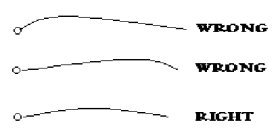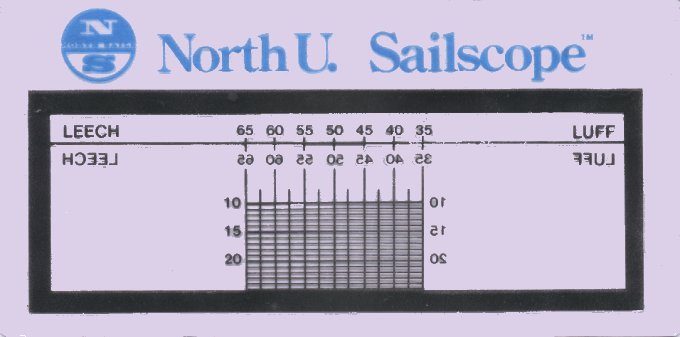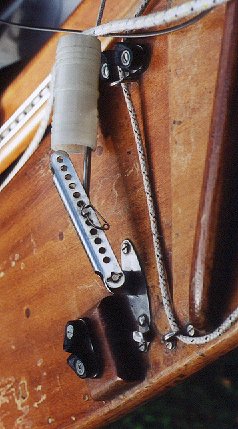Desired
Result: The mast should be as straight as possible
athwartships
(from side to side) while under sailing load. The key factor in
achieving
this is chocking the mast on both sides to remove all "play" (see
photo
below where, on W3854, we use plywood chocks lined with the hard
plastic
stuff they use for kitchen table tops, etc. which we "glue" in with
silicone
sealer):
 At the same time, the ideally curved mast would have fore and aft bend such that the mainsail, throughout its entire height, has a fair, even curve from luff to leech. * If the mast has too little bend, you will get the draft too far forward in the main (see top illustration, below) * Too much bend flattens the forward part of the main excessively (middle illustration, below) * The right amount of bend matches the luff curve installed by the sailmaker and gives a nice even curve from luff to leech (bottom diagram, below)  IMPORTANT:All your numbers and settings regarding mast and spreaders and rig tension are basically only a means to getting this desired sail shape. In the final analysis, nothing else really matters. Former Fireball World Champion, Joan Ellis, once said that all their rig changes across the spectrum of conditions were simply aimed at making sure their sail kept the shape the sailmaker designed for it. In Wayfarers, I would suggest that it is necessary to make slight adjustments to the basic shape as follows: 1. when consistently overpowered: flatten the sail but keep the even curve. To do this, you use the vang to bend the mast more than usual (4 to 6") and then add sufficient main cunningham to drag the draft back forward until your fore/aft curve is even. (also see the stuff about spreaders later in this article since it is easy to let the mast bend too easily which decreases leech tension and kills pointing!!!!!) 2 when sailing in difficult steering conditions: sail with a draft further forward shape to create a larger, more forgiving steering groove. This is usually done by underbending the mast and/or adding lots of cunningham. How the aforementioned is achieved on SHADES Our spreaders are 1’8” long, measuring from the side of the mast to the inside edge of the shroud, and their fore/aft angle is adjustable by means of the blue Proctor spreaders with the wing-nut bolt at the inboard end. Mast bend of 2 - 3” at spreader height makes our main set in the desired shape under average conditions. We measure the bend by means of inch marks (indelible magic marker) going out from the aft edge of the luff rope at spreader height, and coloured whipping thread stretched from the masthead to the gooseneck with a loop of shock cord at the lower end . Uncle Al’s note: This system is my own invention: Using indelible black magic marker, put four “inch-marks” on the luff of the sail at spreader height, starting at the luff rope. Fasten about 18-19’ of coloured whipping thread to/near the aft edge of the top of the mast. Tie a 6” loop of thin shock cord to the other end. The thread should be of such a length as to put some tension on the thread once the shock cord is looped around the gooseneck or its wingnut. We do this so that the thread runs down the starboard side of the mainsail. With this system, we can adjust mast bend (spreader angle mostly) out on the water before the race(s). We then sail close-hauled on starboard and see which inch-mark the thread passes. In medium airs, our mainsail has its max. draft nicely at 50% aft when we have 2-3” of mast bend. Other sails may be slightly different. I’m
not good at judging stuff like draft position and sight up the sail
using
a little plastic gizmo called a Sailscope put out by North Sails as
part
of their North U. Fast Course which has a grid marked on it (see
image
below). (I bought a couple of these separately as spares from
the
North Sails loft in Toronto in the early 90's but am not sure if
they're
still available. The gentleman who designed the whole course is Dave
Dellenbaugh who now publishes the Speed
'n' Smarts newsletter!)  In medium air, angling the spreaders for a shroud to shroud distance of 38” gives us the desired 2-3” of bend when the mast is fully chocked at deck level. It is important to start any adjustment of spreader angle with both spreaders at an equal fore/aft angle. To check that this is so, put the rig under a bit of tension, then stand about 10-15’ out the side of your boat while sighting through the two shrouds (with one eye closed). If the spreaders are evenly angled as they should be, the far shroud should remain hidden behind the nearer one all the way from deck to spreader level. If this is not so, one of your spreaders needs to be angled more or the other less. Subsequent spreader angle adjustment is then simply a matter of applying an equal number of (half) turns to each side. I am still looking for a useful way of keeping my wingnuts from coming slowly undone as the day wears on. I have tried heavy elastics but these don’t seem to last more than one regatta. Suggestions, anyone? In lighter airs, we
want to
maintain 2-3” of bend but Wayfarers have no obvious means of doing so.
Our three main sources of promoting bend will leave us with more ills
than
the bend cures in the lighter stuff: We can, of course, make the mast more willing to bend by angling the spreaders further aft and removing all mast chocks so that minimal rig and sheet tension give us some bend. But what if there is virtually no wind? What we have done on SHADES is to install a miniature “take-up tackle” that resembles a tiny Laser vang using 4 mil. pre-stretched rope at the bottom of the forestay. If we’re really desperate for bend in those super-light airs, we can then crank up the jib halyard to heavy air tension to put compression forces on the mast. When we push the middle of the mast forward, we now get bend in proportion to the rig tension exerted. We then take up all the slack in the forestay (with our mini-vang) and loosen the jib halyard until we have a nicely curved jib luff entry while the rigging is still tight enough to give the mast ample compression and bend. In the really light stuff, we have successfully gone with up to 4” of bend and no chocks at the front of the mast to give the feeble airs an easier, flatter curve to negotiate. As the wind increases towards overpowering, the reverse is true. We want to make it tougher for the mast to bend which means spreaders angled further forward (about 39” or more from shroud to shroud) and chocks in or the mast will easily bend too much. In the latter case, main leech becomes too floppy and the boat will not point!!!! In survival conditions, the mast will bend 4+” even with spreaders angled well forward, once extreme vang is applied (as it should be!). This is something one has to live with, as far as I know. All we can do to help the sail shape is to put on enough of cunningham to remove diagonal folds between mast and boom. Recommended rake
for light
and medium airs is 23’ 5 to 6” at medium rig tension (about 330 lb.).
For really heavy
air, we sometimes
move down one hole (about ¼ inch) on our shroud plates (see
photo
below) to increase the rake and open the slot between main and
jib.
This means less distance (23’ 2 to 3”) between mast tip and traveller/
bridle.  The outhaul is fully extended to the black band only in very light or heavy air. Otherwise, it is off 3 to 4” for extra power until backwind becomes a problem. The cunningham is used only enough to remove major creases from the luff as the wind starts to blow fairly hard. (Another use we have recently found for the cunningham is to stretch our luff tape which has shrunk over the years, and thus keep the worst wrinkles out of the luff without stretching the luff cloth itself.) Mainsheet and vang: Until we get overpowered, we use no vang when close-hauled. We sheet in until the upper leech ticker begins to get sucked in behind the main - even a bit more once we have good speed up in fairly flat water (like going into second gear!). Once we get overpowered, we use increasing amounts of vang and sheet in as far as we can without putting excessive heel (=helm) on the boat. Leech ticker: On our main, we use just one 6” wind tuft, on the leech at about 3/4 height. Made of wool to ensure continued function even in rain, it is attached by threading the wool through a needle and putting a Figure 8 knot in the long end. We then slide the needle inside the fold of cloth at the leech, letting the needle come out the aft end. Pull through until the stopper knot is wedged safely inside the fold where it will not catch the rest of the ticker. WIT home page |